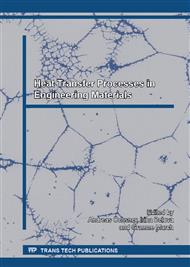[1]
G.J. Ranque: Journal Physique et le Radium, Vol. 7, No. 4 (1933), p.112.
Google Scholar
[2]
G.J. Ranque, U.S. Patent 1,952,281 (1934).
Google Scholar
[3]
R. Hilsch: The Review of Scientific Instruments, Vol. 18, No. 2 (1947).
Google Scholar
[4]
W. S. Stone and T. A. Love, 1950, "An Experimental Study of the Hilsch Tube and Its Possible Application to Isotope Separation", Report ORNL 282.
DOI: 10.2172/4369509
Google Scholar
[5]
K. Bornkessel and J. Pilot, 1962, "Zur Gas-und Isotopentrennung im Wirbelrohr", Z, phys. Chem. 221, 177.
DOI: 10.1515/zpch-1962-22116
Google Scholar
[6]
E. W. Becker, "Methods for the Separation of Uranium Isotopes, Kerntechnik, 11, 129.
Google Scholar
[7]
C. U. Linderstrøm-Lang, 1971, "Studies on Transport of Mass and Energy in the Vortex Tube. The significance of the secondary flow and its interaction with the tangential velocity distribution", Risö Report No. 248 (ISBN 8755001017), Danish Atomic Energy Commission, Research Establishment Risö, Roskilde.
Google Scholar
[8]
C. U. Linderstrøm-Lang, 1967, "A Model of the Gas Separation in a Ranque-Hilsch Vortex Tube", Acta Polytech. Scand., Phys. Ser. No. 45.
Google Scholar
[9]
C. U. Linderstrøm-Lang, 1967, "On Gas Separation in Ranque-Hilsch Vortex Tubes", Z. Naturforsch. 22a (1967) 835.
DOI: 10.1515/zna-1967-0537
Google Scholar
[10]
R. Westley, 1954, "A Bibliography and Survey of the Vortex Tube", Cranfield Note No. 9.
Google Scholar
[11]
B. M. Dobratz, 1964, "Vortex Tubes. A Bibliography", UCRL-7829.
Google Scholar
[12]
C. Gao, 2005, "Experimental Study on the Ranque-Hilsch Vortex Tube", Ph.D. Thesis, Technische Universiteit Eindhoven, the Netherlands.
Google Scholar
[13]
L. Khodorkov, N. V. Poshernev, and M. A. Zhidkov, 2003, "The Vortex Tube - a universal device for heating, cooling, cleaning, and drying gases and separating gas mixtures", Chemical and Petroleum Engineering, 39(7-8):409–415.
DOI: 10.1023/a:1026336813155
Google Scholar
[14]
J. Marshall, 1977, "Effect of operating conditions, physical size and fluid characteristics on the gas separation performance of a Linderstrøm-Lang vortex tube", Int. J. Heat Mass Transfer, 20:227–231.
DOI: 10.1016/0017-9310(77)90209-5
Google Scholar
[15]
Method of natural gas liquefaction, April 2003, Russia patent No. 2202078 C2.
Google Scholar
[16]
H. Takahama, H. Kawamura, S. Kato, and H. Yokosawa, 1979, "Performance characteristics of energy separation in a steam-operated vortex tube", Int. J. Engng. Sci., 17:735–744.
DOI: 10.1016/0020-7225(79)90048-x
Google Scholar
[17]
R. L. Collins and R. B. Lovelace, 1979, "Experimental study of two-phase propane expanded through the Ranque-Hilsch tube", Trans. ASME, J. Heat Transfer, 101:300–305.
DOI: 10.1115/1.3450964
Google Scholar
[18]
K. T. Raterman, M. Mckellar, A. Podgomey, D. Stacey, and T. Turner, 2001, "A vortex contactor for carbon dioxide separations", In First National Conference on Carbon Sequestration. National Energy Technology Laboratory, U.S.A., http://www.netl.doe.gov/ publications/proceedings/01/carbon seq/7b3.pdf.
Google Scholar
[19]
M. R. Kulkarni and C. R. Sardesai, 2002, "Enrichment of Methane concentration via separation of gases using vortex tubes", J. Energy Engrg, 128(1):1–12.
DOI: 10.1061/(asce)0733-9402(2002)128:1(1)
Google Scholar
[20]
N. V. Poshernev and I. L. Khodorkov, 2004, "Natural-gas tests on a conical vortex tube (CVT) with external cooling", Chemical and Petroleum Engineering, 40(3-4):212–217.
DOI: 10.1023/b:cape.0000033678.73190.e8
Google Scholar
[21]
R. T. Balmer, 1988, "Pressure-driven Ranque-Hilsch temperature separation in liquids", Trans. ASME, J. Fluids Engineering, 110:161–164.
DOI: 10.1115/1.3243529
Google Scholar
[22]
A. Gutsol. The Ranque effect. Physics-Uspekhi, 40(6):639–658, 1997.
DOI: 10.1070/pu1997v040n06abeh000248
Google Scholar
[23]
A.I. Leont'ev. Gas-dynamic methods of temperature stratification (a Review). Fluid Dynamics, 37(4):512–529, 2002.
Google Scholar
[24]
C. D. Fulton, 1950, "Ranque's Tube", J. ASRE Refrig. Eng. 58 (1950) 473–479.
Google Scholar
[25]
G.W. Scheper. The vortex tube–internal flow data and a heat transfer theory. J. ASRE Refrigerating Engng, 59:985–989, 1951.
Google Scholar
[26]
J.E. Lay. An experimental and analytical study of vortex-flow temperature separation by superposition of spiral and axial flow, part II. Trans. ASME J. Heat Transfer, 81:213–222, Aug. 1959.
DOI: 10.1115/1.4008187
Google Scholar
[27]
A. Gutsol. The Ranque effect. Physics-Uspekhi, 40(6):639–658, 1997.
DOI: 10.1070/pu1997v040n06abeh000248
Google Scholar
[28]
F. Kreith and D. Margolis. Heat transfer and friction in turbulent vortex flow. Flow, Turbulence and Combustion, 8(1):457 – 473, January 1959.
DOI: 10.1007/bf00411769
Google Scholar
[29]
R.Z. Alimov. Flow friction and heat and mass transfer in a swirled flow. Journal of Engineering Physics and thermophysics, 10(4):251 – 257, April 1966.
DOI: 10.1007/bf00837815
Google Scholar
[30]
A.J. Reynolds. On the dynamics of turbulent vortical flow. Z. angew. Math. Phys., 12:149–158, 1961.
Google Scholar
[31]
A.J. Reynolds. Energy flow in a vortex tube. Z. Angew. Math. Phys., 12:343–356, 1961.
Google Scholar
[32]
R.G. Deissler and M. Perlmutter. Analysis of the flow and energy separation in a turbulent vortex. Int. J. Heat Mass Transfer, 1:173–191, 1960.
DOI: 10.1016/0017-9310(60)90021-1
Google Scholar
[33]
M. Kurosaka. Acoustic streaming in swirling flow and the Ranque-Hilsch (vortex-tube) effect. J. Fluid Mech., 124:139–172, 1982.
DOI: 10.1017/s0022112082002444
Google Scholar
[34]
J.G. Chu. Acoustic streaming as a mechanism of the Ranque-Hilsch effect. PhD dissertation, University of Tennessee, Knoxville, Dec. 1982.
Google Scholar
[35]
H. Kuroda. An experimental study of temperature separation in swirling flow. PhD dissertation, University of Tennessee, Knoxville, Dec. 1983.
Google Scholar
[36]
B. Ahlborn and S. Groves. Secondary flow in a vortex tube. Fluid Dynamics Research, 21:73–86, 1997.
DOI: 10.1016/s0169-5983(97)00003-8
Google Scholar
[37]
C.M. GAO, K.J. Bosschaart, J.C.H. Zeegers, and A.T.A.M. de Waele. Experimental study on a simple Ranque-Hilsch vortex tube. Cryogenics, 45(3):173, 2005.
DOI: 10.1016/j.cryogenics.2004.09.004
Google Scholar
[38]
W. Frohlingsdorf, 1997, "Unterschungen zur kompressiblen Str¨omung und Energietrennung im Wirbelrohr nach Ranque und Hilsch", PhD dissertation, Ruhr-Universitat-Bochum.
Google Scholar
[39]
A. Gutsol and J.A. Bakken. A new vortex method of plasma insulation and explanation of the Ranque effect. J. Phys. D: Appl. Phys., 39:704–711, 1998.
Google Scholar
[40]
G.F. Nellis N.F. Aljuwayhel and S.A. Klein. Parametric and internal study of the vortex tube using a cfd model. International Journal of Refrigeration, 28(2):442–450, 2005.
DOI: 10.1016/j.ijrefrig.2004.04.004
Google Scholar
[41]
B. Ahlborn and J.M. Gordon. The vortex tube as a classic thermodynamic refrigeration cycle. J. Appl. Phys., 88(6):3645–3653, 2000.
DOI: 10.1063/1.1289524
Google Scholar
[42]
K. Dincer, A. Avci, S. Baskaya, and A. Berber, Experimental investigation and exergy analysis of the performance of a counter flow Ranque-Hilsch vortex tube with regard to nozzle cross-section areas, International Journal of Refrigeration 33 (2010) 954-962.
DOI: 10.1016/j.ijrefrig.2010.03.009
Google Scholar


